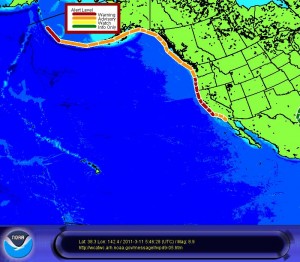Earlier: 1:45 a.m. PST message from the West Coast and Alaska Tsunami Warning Center: A tsunami warning is now in effect from Point Concepcion, on the lower Central California coast, all the way to the mouth of the Columbia River on the Oregon-Washington coast.
Advisory from West Coast and Alaska Tsunami Warning Center
Here’s the boilerplate language from the Tsunami Warning Center on what the warning means:
A Tsunami Warning means that all coastal residents in the warning area who are near the beach or in low-lying regions should move immediately inland to higher ground and away from all harbors and inlets including those sheltered directly from the sea. Those feeling the earth shake, seeing unusual wave action, or the water level rising or receding may have only a few minutes before the tsunami arrival and should move immediately. Homes and small buildings are not designed to withstand tsunami impacts. Do not stay in these structures.
All residents within the warned area should be alert for instructions broadcast from their local civil authorities. A tsunami has been recorded.
And here’s another detail to take note of: the tsunami danger will remain after the first impulse arrives:
TSUNAMI AMPLITUDES ARE EXPECTED TO PEAK TWO TO THREE HOURS AFTER INITIAL ARRIVAL ALONG THE NORTH AMERICAN COAST.
Tsunamis can be dangerous waves that are not survivable. Wave heights are amplified by irregular shoreline and are difficult to forecast. Tsunamis often appear as a strong surge and may be preceded by a receding water level. Mariners in water deeper than 600 feet should not be affected by a tsunami. Wave heights will increase rapidly as water shallows. Tsunamis are a series of ocean waves which can be dangerous for several hours after the initial wave arrival. DO NOT return to evacuated areas until an all clear is given by local civil authorities.
Other tsunami resources:
City of San Francisco tsunami preparedness site
Tsunami Inundation Maps from the California Department of Conservation. Note: These maps show areas that are prone to inundation, not areas expected to be inundated by any tsunami that appears in the wake of Japan’s Great 2011 Earthquake.
